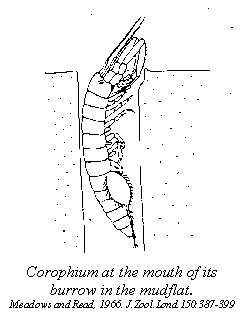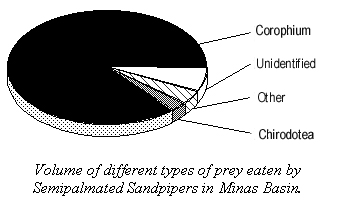FUNDY ISSUES #3
Autumn 1996
SANDPIPERS AND SEDIMENTS:
Shorebirds in the Bay of Fundy
"successful foraging in the productive Fundy mud is critical for
up to 95 percent of the world's population of Semipalmated Sandpipers"
The Sandpiper Ballet

The intricate aerial ballet of the Semipalmated Sandpiper is without doubt one of the most awe inspiring summertime phenomena in all of Fundy. As the rising tide inundates the endless expanses of sticky brown mud that fringe Minas Basin and Chignecto Bay, hundreds of thousands of these sparrow-sized "peeps" erupt into the air in restless twittering flocks. Then, as if responding instantaneously to the inspired, dramatic choreography of an unseen conductor, they begin to soar, swoop and bank in exquisite unison, skimming low over waves and beaches, rising and falling in graceful feathered drifts of blurred blacks, browns and silvery whites. Eventually they settle, or "roost", nervously huddled together in immense flocks on the thin strips of remaining beach, resting and awaiting the reappearance of their mudflats.
The "Lifeless" Mud?
The sandpiper's aerobatics have awed and thrilled residents and visitors alike for centuries. Their life story and their evident attachment to the mudflats have puzzled scientists for decades. Peter Hicklin, a wildlife biologist with the Canadian Wildlife Service (Environment Canada) in Sackville, New Brunswick, has devoted his career to "listening to what the sandpipers have to tell me". Painstakingly, he has slowly pieced together much of their remarkable life story. He knew already that up to two million sandpipers and other shorebirds stop over in the Fundy region during July and August on their remarkable annual migration from their spring breeding grounds, far to the north on the arctic Tundra near Hudson Bay, to their overwintering grounds along the coasts of South America. But, when he began, as a graduate student at Acadia University in nearby Wolfville more than 20 years ago, the considered opinion of many scientists and most residents, was that the vast oozing expanses of mud were a virtually lifeless and inhospitable wasteland. Why then, he wondered, did these huge flocks of shorebirds arrive here every summer and spend so much time far out on the mudflats, running back and forth in seemingly mindless confusion? Surely they were there for a reason.
A Fundy Feast

By carefully sieving through hundreds of samples of the "lifeless" mud he soon found that it teemed with unimaginable numbers of tiny marine creatures, particularly a shrimp-like amphipod crustacean known as Corophium volutator. These tiny invertebrates, each about the size of a large grain of rice, live just under the surface of the mud in tiny u-shaped tubes which they construct by gluing together fine particles of sand. As many as 60,000 of them are sometimes found crowded under an area about the size of a bath towel. As the tide falls, they emerge in their countless millions and scuttle about on the damp mud, seeking mates or browsing on microscopic algae and other flecks of organic matter littering the surface or coating the mud particles. However, within 20 minutes the mud begins to feel uncomfortably warm and dry and the Corophium quickly return to the comfort and security of their damp, cool burrows.
It is these teeming Corophium that the hungry sandpipers seek as they race about the mudflats slowly emerging from the sea. They have learned that by carefully following the ebbing tide as it recedes down the flat, they can find the largest numbers of amphipods right on the mud surface. And the sandpipers need all the Corophium they can get, for they must store enough fat in their bodies to provide all the energy needed for their non-stop 4000 kilometre trip over open ocean to their overwintering grounds in South America. They arrive on the shores of Fundy very lean and hungry, and a short two weeks later depart very fat and almost twice as heavy. Even then, calculations of their energy requirements in flight clearly show that all this fat is just barely sufficient for the journey. There is little, if any, left in reserve upon arrival at their South American destination. Thus, successful foraging in the productive Fundy mud is critical for up to 95 percent of the world's population of Semipalmated Sandpipers, as well as for thousands of other migrating shorebirds that frequent the area during the summer.
An "Ecological Cascade"

However, the story of the sandpipers and their dependence on Corophium is only one chapter of the complex ecological epic that plays out each year, far out on the mudflats of Fundy. Other researchers, such as Graham Daborn at the Acadia Centre for Estuarine Research and Carl Amos at the Bedford Institute of Oceanography, have been carefully unraveling other parts of the intriguing puzzle, particularly those involving the mud itself. They are especially interested in the processes involved in the formation and erosion of these ever-changing marine "mudscapes".
One of the properties that they measure frequently is the "strength" or stickiness of the mud. This is an indicator of its ability to resist being washed away by tidal currents or waves. They were baffled at first when they found that the "strength" of the mud increases markedly when the great flocks of shorebirds arrive in Fundy on their southward journey. Further investigation revealed a fascinating chain of events that Daborn has called "an ecological cascade". In summer the damp, fertile surface of the mud glistens greenly with microscopic plants (algae) growing profusely in the bright sun. These excrete a gelatinous organic substance termed "muccopolysaccharide". This increases the natural stickiness of the surrounding sediment particles and thus makes the mud surface firmer and less likely to be swept away. The armies of grazing Corophium, however, eat large amounts of this algae, resulting in less muccopolysaccharide being produced and leaving the mud more susceptible to erosion. The amphipods constant burrowing and grazing activities also disturbs and loosens up the mud (a process called "bioturbation").
However, when the vast flocks of hungry sandpipers arrive they eat immense numbers of the amphipods, greatly reducing their numbers, and allowing the rapidly growing algae to flourish. Thus more muccopolysaccharide is produced and the sediments become stickier and more stable. In this way, a fine and intricate balance is established between sediment composition, stability of the mudflat surface, the growth of the algae, the abundance of grazing amphipods and the feeding of voracious sandpipers. Disturb any one of these fragile links and the consequences reverberate both up and down this carefully forged ecological chain, threatening its whole structure.
"Strained" Links?
In recent years Peter Hicklin has been alarmed to find indications that some of these fragile links are indeed being strained, with consequences that could in time be catastrophic for the sandpipers. In 1993 he sent some visiting students out to observe "peep" feeding behaviour on mudflats that he had studied intensively 15 years earlier. He was puzzled when they returned and described foraging behaviour unlike anything that he had observed.
A more detailed examination of the site not only confirmed the students' report, but brought to light other alarming changes. Where once the intertidal mud had been relatively firm underfoot it was now watery and "soupy". In addition, Corophium were completely absent in areas where there had previously been up to 30,000 of them per square metre. The changes in sandpiper foraging behaviour were clearly related to these alterations in the distribution and abundance of their principal prey, which in turn seemed to be a result of changes in the nature of the mud itself. The water content had almost doubled, and the proportion of very fine silt/clay had greatly increased. Apparently, the Corophium were no longer able to build stable burrow walls in the water-logged mud.
Further observations indicate that these changes have taken place on several mudflats, although it is not yet clear how widespread the phenomenon is. Scientists are also unsure whether these changes are solely a result of human activities or are due to natural changes, such as gradually rising sea level or long-term changes in the height of the tides. However, there is a nagging suspicion that damming of most of the rivers flowing into the Bay of Fundy during the 1950's and 60's contributed to these changes in the sediments. Could it be that some of the environmental effects of all these dams are just now becoming noticeable? An example of the dramatic effect of such barriers on sediment distribution in rivers and estuaries can be seen from the causeway across the Avon River at Windsor, Nova Scotia. In the 27 years since the construction of this barrier a vast expanse of thick brown mud has formed below it, with pronounced shallowing of the estuary for more than 8 kilometres downstream. Spreading marine grasses and other plants, are now slowly transforming this mudflat into a saltmarsh.
Paradox of the "Peeps"
Paradoxically, in spite of these disturbing indications of changes in their food supply and mudflat habitat, periodic bird counts suggest that the sandpiper numbers in the Bay have steadily increased in recent years. This seems strangely at odds with reliable reports from South America that their numbers are dwindling on their overwintering grounds. However, closer investigation suggests that the increase in numbers in Fundy may be illusory. It is thought that the successive waves of birds migrating through the region may be staying longer than the previous average of about two weeks. This results in a piling up of the migrants. Could it be that it is taking them longer to find enough Corophium to put on the crucial reserves of fat required for completing their migration? Have the dams upset the delicate ecological balances among sediments, mudflats, algae, Corophium and sandpipers? Scientists and wildlife managers are not quite ready to point the finger, but many of them are clearly worried. Peter Hicklin and many other concerned experts feel that we must act quickly and decisively if sandpipers are to have a future in Fundy.
Already, the principal habitats where the sandpipers congregate, in both the Fundy region and elsewhere, have been set aside as Hemispheric Shorebird Reserves to protect the birds at their most critical staging areas. However, this may not be enough if the refuges themselves are gradually changing in ways that make them less suitable for shorebird feeding. The Canadian Wildlife Service has given a high priority to getting a better scientific understanding of the problem and to ensuring the survival of these engaging "peeps" and their dramatic aerial ballet for the enjoyment and inspiration of generations to come.
Further Reading
Written and produced by J.A. PercyUse of invertebrate fauna and associated substrates by migrant shorebirds in the southern bight, Minas Basin. P.W. Hicklin, M.Sc. Thesis, Acadia Univ., Wolfville, N.S. 1981Selection of foraging sites and invertebrate prey by migrant Semipalmated Sandpipers Calidris pusilla (Pallas) in Minas Basin, Bay of Fundy. P.W. Hicklin and P.C. Smith, Canadian Journal of Zoology. Volume 62, pages 2201-2210. 1984.
Life history and reproductive biology of Corophium volutator (Crustacea:Amphipoda) and the influence of shorebird predation on population structure in Chignecto Bay, Bay of Fundy, Canada. D.L. Peer, L.E. Linkletter and P.W. Hicklin, Netherlands Journal of Sea Research. Volume 20, number 4 pages 359-373. 1986
Changes in sediment types and invertebrate fauna in the intertidal mudflats of the Bay of Fundy between 1977 and 1994. P.C.F. Shepherd, V.A. Partridge and P.W. Hicklin, Technical Report Series. Number 237, Canadian Wildlife Service, Conservation Branch, Environment Canada. 1995.
An ecological cascade effect: migratory shorebirds affect stability of intertidal sediments. G.R. Daborn et al. Limnology and Oceanography. Volume 38, pages 225-231. 1993.
The Clean Annapolis River Project, P.O. Box 395, Annapolis Royal, Nova Scotia B0S 1A0
Tel: (902)532-7533 Fax: (902)678-1253 e-mail: shawboldt@fox.nstn.ns.ca
The Bay of Fundy Ecosystem Project is supported by Environment Canada,
the Department of Fisheries and Oceans Canada and the Acadia Centre for Estuarine
Research.
This publication is financially supported by the Gulf of Maine Council on the Marine
Environment.
It may be reproduced with credit to the Clean Annapolis River Project.